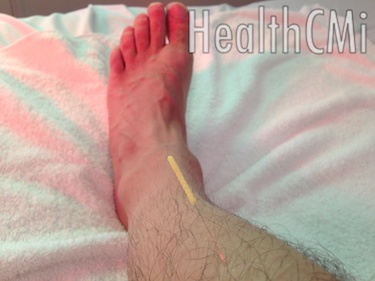Acupuncture prevents and reverses dangerous cellular accumulations of fatty materials in cases of high cholesterol thereby preventing atherosclerotic plaques and heart disease. New laboratory research confirms that needling a specific acupuncture point located on the lower leg prevents and reverses the formation of foam cells. This type of cell forms at the site of fatty streaks and is the beginning of atherosclerotic plaque formation in blood vessels.  The presence of foam cells is indicative of an increased risk of heart attacks and strokes. Based on the research, the investigators note that acupuncture could “play an essential role in treating hyperlipidemia (high cholesterol and triglycerides) and stopping it from developing into a further level.”
The presence of foam cells is indicative of an increased risk of heart attacks and strokes. Based on the research, the investigators note that acupuncture could “play an essential role in treating hyperlipidemia (high cholesterol and triglycerides) and stopping it from developing into a further level.”
Oxidized LDL cholesterol creates inflammation within blood vessels. As a result, immune system cells called macrophages are attracted to the site of inflammation and consume the LDL cholesterol. Ordinarily, macrophages defend against bacteria and other pathogens. However, macrophages can become engulfed in fatty materials when attempting to eliminate excess cholesterol. Under a microscope, one can see that the macrophages become overrun with cholesterol and other fatty materials. The damaged macrophages take on a foamy appearance, hence the name foam cell. Foam cells indicate that dangerous plaques are beginning to form within the vessels. The researchers conclude that electroacupuncture at acupuncture point ST40 (Fenglong) “prevents and reverse(s) the formation of foam cell(s).” In this way, acupuncture helps to fight hyperlipidemia and prevent heart disease.
The research proves that ST40 electroacupuncture “significantly prohibits the transformation of macrophage(s) into foam cell(s).” The research measured sharp reductions in foam cells through the application of acupuncture. Stimulation of acupoint ST40 was shown to decrease the cholesterol content of macrophages. Cells can accomplish this in two ways. The first way is to convert cholesterol into cholesterol esters. This method is limited because it may overrun cells with esters and consequent toxicity.
Needling acupuncture point ST40 accomplishes cholesterol reduction by another method that is completely non-toxic. ST40 stimulation increases the rate of cholesterol efflux from macrophages. Cholesterol efflux is a process of eliminating cholesterol from cells that is regulated by intracellular transporters including ATP proteins A1, G1 and B1. Unlike the cholesterol ester process, the efflux process has a virtually unlimited capacity to reduce cholesterol because there is no danger of building up excess cellular cholesterol esters. Needling ST40 with electroacupuncture activates an important, safe and powerful method for cells to reduce excess cholesterol content.
Getting To The Point
ST40 is located on the lower leg and is midway between the popliteal crease and the lateral malleolus, two finger-breadths lateral to the anterior crest of the tibia. This is approximately the midpoint between the knee and the ankle on the lateral portion of the lower leg. According to Traditional Chinese Medicine (TCM), this point stimulates the transformation of phlegm and dampness. This TCM function is consistent with the new research. ST40 reduces excess cholesterol accumulations from cells. Lipids are categorized as a form of dampness in TCM. In this way, ST40’s ability to engage cholesterol efflux is a biological correlate for the TCM function of transforming dampness.
ST40 is also ascribed the function of benefitting the chest in the TCM system. This too is consistent with the new research in that ST40’s ability to increase cholesterol efflux helps to prevent heart disease. The TCM system also documents that ST40 calms the spirit and is indicated for the treatment of , vertigo, coughs, excess sputum, chest pain and swelling of the lower limbs. ST40 (Fenglong, Abundant Bulge) is an important acupuncture point in the TCM system because it is a Luo-connecting point to the Spleen Leg-Taiyin channel. 
Online Acupuncture Continuing Education
Acupuncture, Chinese medicine dietetics and herbal medicine are all part of the TCM system for the treatment of high cholesterol and high triglycerides. Visit the HealthCMi.com acupuncture CEU (continuing education unit) web page to learn more about online continuing education courses for the treatment of high cholesterol and triglycerides with TCM. Licensed acupuncturists receive state and nationally approved acupuncture continuing education CEUs, NCCAOM Diplomate PDAs, CAEs and CEs for HealthCMi online courses.
Macrophage Research
The recent foam cell research on the beneficial effects of acupuncture on macrophages comes at a time when other remarkable research has emerged. Recently, an investigation published in Molecular Neurobiology reveals that acupuncture reduces inflammation and muscle pain by downregulating M1 macrophages (pro-inflammatory cells) and upregulating M2 macrophages (anti-inflammatory cells). The study measured responses in muscle tissues and confirms that M1 to M2 macrophage phenotype switching is triggered by acupuncture stimulation. Acupuncture stimulates biological actions wherein inflammatory responses are reduced and cellular healing responses are engaged.
References:
Chen, Y. F., J. Y. Tian, Y. Xiao, H. Wu, H. Huang, and H. X. Zhang. "Effects of electroacupuncture at" Fenglong"(ST 40) on formation of macrophage-derived foam cell and efflux of cholesterol in hyperlipidemia rats." Zhongguo zhen jiu= Chinese acupuncture & moxibustion 34, no. 5 (2014): 475.
Low H1, Hoang A, Sviridov D. Cholesterol efflux assay. J Vis Exp. 2012 Mar 6;(61):e3810. doi: 10.3791/3810.
da Silva, Morgana D., Franciane Bobinski, Karina L. Sato, Sandra J. Kolker, Kathleen A. Sluka, and Adair RS Santos. "IL-10 Cytokine Released from M2 Macrophages Is Crucial for Analgesic and Anti-inflammatory Effects of Acupuncture in a Model of Inflammatory Muscle Pain." Molecular Neurobiology (2014): 1-13.


